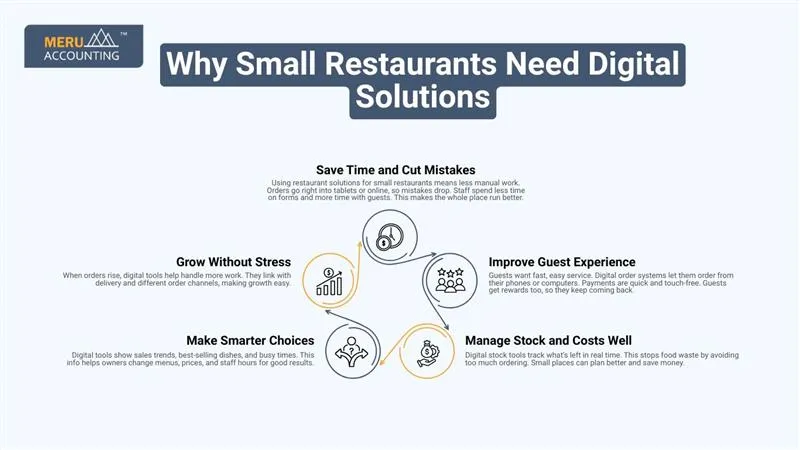Why Digital Restaurant Solutions for Small Restaurants Are a Must
Small restaurants face many tough tasks each day. Managing orders, stock, staff, and guests with few resources can be hard. That is why restaurant solutions for small restaurants are needed. These tools help owners save time, cut costs, and give guests a better experience. This blog shows why digital solutions matter, what tools exist, and how small restaurants can gain from them.
What Are Digital Restaurant Solutions?
Digital restaurant solutions, also called restaurant solutions for small restaurants, are apps and software that help restaurants run well. These tools cover things like:
- Taking orders online or at the counter
- Managing stock automatically
- Scheduling staff with ease
- Tracking sales and how the restaurant does
- Talking to guests with loyalty programs
These tools make work simple and keep small restaurants on track.
Why Small Restaurants Need Digital Solutions
1. Save Time and Cut Mistakes
- Using restaurant solutions for small restaurants means less manual work. Orders go right into tablets or online, so mistakes drop. Staff spend less time on forms and more time with guests. This makes the whole place run better.
2. Improve Guest Experience
- Guests want fast, easy service. Digital order systems let them order from their phones or computers. Payments are quick and touch-free. Guests get rewards too, so they keep coming back.
3. Manage Stock and Costs Well
- Digital stock tools track what’s left in real time. This stops food waste by avoiding too much ordering. Small places can plan better and save money.

4. Make Smarter Choices
- Digital tools show sales trends, best-selling dishes, and busy times. This info helps owners change menus, prices, and staff hours for good results.
5. Grow Without Stress
- When orders rise, digital tools help handle more work. They link with delivery and different order channels, making growth easy.
Common Digital Tools for Small Restaurants
- Point of Sale (POS) Systems
POS systems are core restaurant solutions for small restaurants. They take orders, handle payments, and track sales in one place. Many work on tablets or phones and sync to the cloud. This lets you manage sales even when away. - Online Ordering and Delivery Tools
These let guests order food online from your site or app. Orders go straight to the kitchen, cutting out mistakes. Delivery can be handled here or linked to third-party services. - Inventory Management Software
These tools track ingredients and supplies. They warn when stock is low and can auto-order more. This keeps the kitchen stocked. - Staff Scheduling and Payroll
Scheduling is easier with digital tools. You can make and share schedules, track hours, and handle pay in one spot. This cuts mix-ups and pay errors. - Customer Loyalty Programs
Loyalty apps reward repeat guests with points, deals, or special offers. They help build good ties and repeat visits. - Marketing and Analytics
Some digital tools handle email marketing, social posts, and guest reviews. They also show sales and guest trends on dashboards.
Benefits of Digital Solutions for Small Restaurants
- Efficiency: Restaurant solutions for small restaurants cut manual work. Tasks like taking orders and tracking stock are fast and right.
- Cost Savings: Less food waste and fewer errors save money. Auto systems cut extra hours too.
- More Sales: Better order control and loyalty programs boost sales. Digital menus and upsells get guests to spend more.
- Better Guest Experience: Fast service, easy ordering, and rewards make guests happy. Happy guests return and spread the word.
- Easier Management: Data at your fingertips helps make quick decisions. Cloud tools let you run the place from anywhere.
How to Pick the Right Digital Tools
- Know Your Needs: Choose what to fix with the best restaurant solutions for small restaurants—orders, stock, staff, or marketing.
- Easy to Use: Pick software that’s simple to learn and use.
- Budget: Many low-cost options exist. Check fees and hidden costs.
- Integration: Make sure tools work well together.
- Support: Choose companies with good help and updates.
- Growth: Pick tools that grow with your business.
How to Use Digital Solutions?
- Start with one area, like POS or online ordering.
- Train your team well before going live.
- Test the system to find and fix issues.
- Ask staff and guests for feedback.
- Add new tools over time to keep things smooth.
Implementing Digital Restaurant Solutions Successfully
- Train Your Staff
Give full training to all team members. Make sure all knows how to use the tools well. - Start Small
Add one tool at a time. Give time to get used to it before adding more. - Watch Performance
Check how digital tools help your business. Ask staff and guests for their thoughts. - Make Changes
Be ready to change settings or try new tools. Stay open to find what works best for your place.
Emerging Trends in Digital Restaurant Solutions for Small Restaurants
As tech grows, new restaurant solutions for small restaurants keep changing small restaurants. Here are some key trends to watch that can help your place stand out:
1. Contactless Payments and QR Code Menus
- More guests like contactless payment for safety and ease. QR code menus let guests see menus on phones, cutting touch and print costs. These make ordering and paying faster, so tables turn quicker.
2. AI-Powered Analytics
- Smart software uses AI to study sales and guest habits. Small restaurants can guess busy times, top dishes, and guests’ likes. This info helps owners make wise choices on menus and staff.
3. Cloud-Based Restaurant Management
- Cloud tools let owners run things from any place. Live access to sales, stock, and staff data helps make quick moves. Cloud systems cut costs on hardware and IT care.
4. Delivery and Third-Party Integration
- Links with apps like Uber Eats and DoorDash boost sales with no extra staff. Auto-syncing orders from these apps cuts errors and work. Small restaurants reach more guests without big upfront costs.
5. Personalized Customer Engagement
- CRM tools help send custom offers to guests. Birthday deals or specials based on past buys build loyalty. Personal contact brings more repeat guests and good word-of-mouth.
How Digital Restaurant Solutions Support Sustainability in Small Restaurants
Small places can also use digital tools to cut their impact on the earth and meet green goals:
- Reduce Food Waste
Stock software alerts when food nears its use-by date. Data on top dishes helps avoid making too much food. - Cut Paper Use
Digital menus, bills, and orders lower paper needs. Online chats with suppliers cut down on paper invoices. - Save Energy
Some tools track how much power kitchen gear uses. This helps find ways to save energy and cut bills.
Real-Life Examples
- Cafe Delight: Used smart restaurant solutions for small restaurants like online orders and stock software. Cut waste by 20%, and gained more repeat guests.
- Family Diner: Switched to tablet POS. Checkout times got 15% faster; staff liked scheduling.
- Pizza Corner: Added loyalty and delivery tools. Got 10 new guests each week and raised sales by using data.
Managing money can be hard for small restaurants. Tracking costs, sales, and taxes takes care and time. This is where Meru Accounting helps a lot. Meru Accounting is a tool made to help small restaurant owners with their books. It tracks costs, makes clear reports, and helps with tax forms. With Meru Accounting, owners spend less time on paperwork and more time on their work. Using tools like Meru Accounting keeps money records right and well-kept. This helps owners make smart choices and grow their business.
FAQs
- What are digital restaurant solutions?
They are apps that help with orders, payments, stock, and marketing. - Are these tools costly?
Many cheap options have low monthly fees. - Are they hard to learn?
Most are user-friendly and offer support. - Can they link with delivery apps?
Yes, many connect to top delivery services. - Do small kitchens benefit?
Yes, they save time, cut waste, and grow sales. - Do these work without the internet?
Some have offline modes, but usually need the internet to sync. - Can they help with marketing?
Yes, with emails, rewards, and review tracking.








